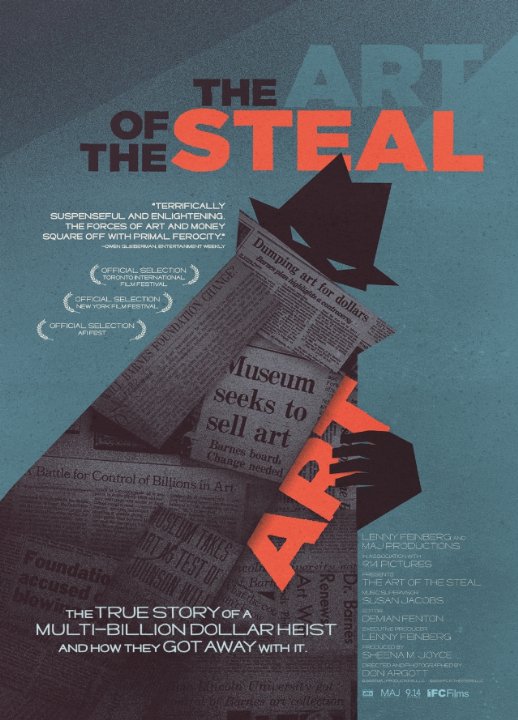The documentary film, The Art of the Steal is a gripping tale of intrigue and mystery in the art world. The film traces the history of the Barnes collection of Post-Impressionist paintings, which was worth billions and became the subject of a power struggle after the 1951 death of the owner. Dr. Albert Barnes collected 181 Renoirs, 69 Cezannes, 59 Matisses, 46 Picassos and many other valuable paintings. Despite his best efforts political wrangling over the collection eventually led to its division and control by the very group of people he wanted the collection to be protected against.
Barnes was a shrewd man. He took pains to hire the best lawyers to erect a trust for his paintings to protect them from every imaginable threat. Ironically, the people, state rats and foundations that would eventually divide, move and control his collection were largely known to Barnes at the time of his death.
For the intriguing story of how they accomplished this I recommend the film.
Barnes drafted his trust in 1922 and modified it many times leading up to his sudden death in 1951. It took 58 years from the time of Barnes’ death before the judges ruling cleared the way for its division which overturned every one of Barnes’ express wishes for his collection and transferred control of what now is $25-$30 billion dollars of art into the very hands Barnes never wanted to to have anything to do with it.
While watching the documentary I was struck both by how long it took the collection to be divided and how short that period was with respect to the magnitude, beauty and importance of the art. It’s reminiscent of what is often said about a Stradivarius Violin: The current owner is merely temporary in the life of the instrument.
Barnes was a great man. As such, we who loathe that his magnificent collection has fallen into enemy hands have no better recourse than to glean from the rubble of this theft every possible lesson of what strategies might have worked in fulfilling Barnes’ true wishes.
The problems started when the Barnes Trust ran out of successor trustees.
Have More Successor Trustees
- Have Children – Barnes had no children. There’s no guarantee that children will fulfill estate wishes but it would have put a few more options on Barnes’ table.
- Designate a Lineage of Trustees – Barnes designated five successor trustees. This is the primary reason his collection was protected for the 58 years it was. Even though five seem like plenty it was not enough. More is better and a methodology for adding them, post-mortem, is even better.
- Have Trustees (Vetted While Grantor is Alive) Designate Successor Trustees – The Trustees Barnes knew while he was alive performed flawlessly. If there was a mechanism in the trust for these trustees to, in turn, vett and add new trustees, this would extend the time and increase the quality of adherence to the original intent of the Grantor (Barnes, in this case).
“Poison Pill” Provisions
To avoid contention between competing trustees “Poison Pills” could be placed in the Trust to squelch trivial squabbles. John Lennon’s estate was famous for ensuring that anyone who contested the terms of the trust be cutout of the trust, as a result. It works!
Map Out Maintenance Strategies Using Corpus of the Trust
At one point, Barnes’ collection was in danger due to problems with the building that contained it. Multiple approved methods of raising money for maintenance could be included in the trust. This would take options away from untrustworthy trustees who see this as a crack in the Trust’s armor. It would also make it easier for good trustees who may not have the business sense to go along with their desire to adhere to the grantors’ wishes.
One option, here, for Barnes would have been a strategic sell-off of some of the collection. As terrible as that may sound Barnes would have been most familiar with his collection. Not everything he chose was untouchable. While alive Barnes might have chosen the order in which a very small number of paintings could be auctioned off for the good of the collection IF that was the only option available to the trustee.
Use Corporation(s), LLC(s) or Complex Structures in Lieu of a Trust
This opens up a whole different can of worms that I’d rather not explore in this article. I only bring it up as an option in reaction to seeing the limits of Barnes’ chosen protective entity: The Trust. The ultra rich typically erect complex structures of multiple entities to protect their wealth while they’re alive. Admittedly, maintaining such structures is much more difficult upon death but perhaps such complexity is necessary in cases like Barnes.
Prohibit Boards as Trustees
The biggest fractures appeared with the Barnes collection when Trustees morphed into boards who created their own rules about how the boards were run. Such boards were free to add members, for instance, that enabled a few members to change the consensus of the board. I’d say the only way to squelch this problem is to prohibit boards of any kind. Groups of people never behave themselves with as much integrity as individuals.
The Nuclear Option
Barnes was a great man. To become so takes a level of determination and single-mindedness that few of the rest of us can probably even imagine. After watching the documentary it occurred to me that Barnes was so determined to keep his collection in tact and out of the hands of his enemies that he never even contemplated a last-ditch option. With the benefit of the hindsight that Barnes’ experience has given me I think his best last ditch option would have been to focus on . . . .
The Creators Not the Creations
In the event that any of Barnes’ parameters were violated he could have put instructions into the trust that all the art in the collection be auctioned off for the benefit of the kinds of artists whose work Barnes so understandably admired. By doing so the actual art in the collection would have been randomly distributed around the world (To be collected by the next Barnes?) and he would have been funding the efforts of new great artists to create more beautiful and inspiring art for Barnes’ desired educational purpose of the art, itself. Not to mention that the existing art would have been put beyond the reach of the contemptible group that now controls it.
I’m not presuming that this is a better use for Barnes’ art than he, himself, imagined. I’m merely pointing out one possible backup option that Barnes probably wouldn’t even let himself consider.
They Ruin Everything They Touch
Greed, power, sociopaths and whatever “Foundations” they hide behind are like water falling on a building: They never stop eroding what they come in contact with. In life it’s often possible to avoid contact, altogether, with these brands of evil. In death, the best one can hope for is to delay the meeting for as long as possible.




